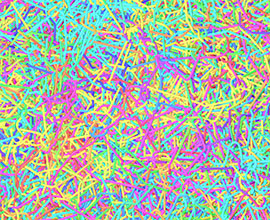How do everyday materials like rubber, plastics, yogurt, shampoo, jelly, glue and paint work? They are all examples of what we call ' soft materials '. I.e. complex materials, which are placed in the border between a liquid and a solid state. Our bodies are built by them, we eat them all the time, in short; we are in contact with soft materials every day. They are also essential in many industrial and technological processes.
But how do these materials actually work? In my group we build molecular models of such materials on the computer. We then run simulations on supercomputers to investigate how their material properties emerge from their molecular structures.
The image at the bottom of the page comes from a simulation of the process of pulling an elastic band. Rubber bands and plastic are made of long wire-shaped, tangled
molecules called polymers. When we pull a rubber band, the structure of the molecules is influenced in a very complicated way, because they are tangled together, and this gives rise to the elastic force we feel when we pull the rubber band.
Models and simulations give us new insight into the fundamental physical relationships between the properties of a molecule and the properties of the materials. By creating visualizations of simulation results, the models and simulations become a microscope that shows us the complicated molecular physics of everyday materials. With the knowledge they give us, we can improve theories, improve the interpretation of experimental results and finally provide input on how to design new materials with better and more useful properties.

